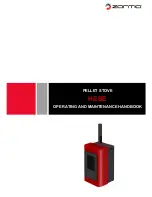
11
In the meantime, by opening the air-intake screw located on the radiators, the air
gaps in the radiators and installation needs to be removed.
CAUTION: Fill the expansion tank halfway through water supply.
Before the activation of the stove, the labels (except the plate) on the stove and the
accessories in the ashtray or fire chamber needs to be removed, as it is only valid
for shipping protection.
5.3 COMBUSTION AND HEATING
First of all put 3-4 bricket wood in the fire chamber and put small pieces of wood
or paper to burn. All existing glass cleaning vents must be open. Then, after
burning the stove, close the fireplace chamber cover. For the air-flow control,
thermostatic regulation setting in the attached information page needs to be
observed.
The stove should be burned carefully during the first use and the flame should be
kept as low as possible. If you burn it carefully, you will prevent the formation of
cracks in the insulating stones, damage the paint and deterioration of the material.
The smell caused by the protective paint on the stove is short-lived, so keep the
doors and windows open.
CAUTION: Our products should not be used to burn environmentally
hazardous waste.
5.3.1 Adding fuel
In addition to suitable fuel, enough chimney extraction and properly use of the
stove has an impact on glass cleaning. In this context, we recommend you to use
wood in a single layer and use wood to fill the width of the large fire chamber.
When opening the flame chamber cover, make sure that the air vent cover of the
mechanical thermostat is closed. After adding the fuel, the flame chamber cover
should be closed and the mechanical thermostat needs to be set.
5.3.2 Use during transition period
In the transitional season or by hot weather, problems may occur in the chimney
output (smoke) draft. To avoid damages in the transitional period, the product
should be operated with less fuel or should not be burned.
































